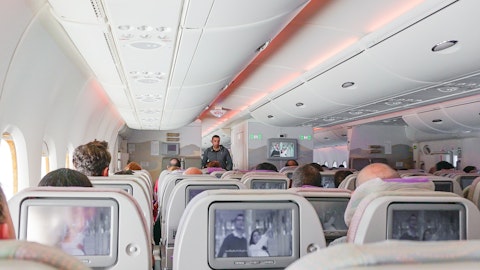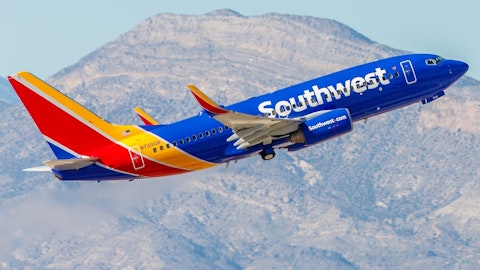Ryan Green : Yeah. I’ll just give some additional color here. The first quarter is a tale of two halves. In the first quarter — the first half of the quarter is very low demand time period, and that was impacted by the cancellations like Bob mentioned. And then it’s just very tough with the hangover from the operational event kind of the first couple of weeks in January to get real traction. We did not want — if you go out and look at the fares that we have published for this time period, there are regular kind of routine promotional fares. We didn’t think it would help to be overly promotional in this time period. But then when you get into the second half of the quarter and President’s Day and beyond and kind of into March, as Bob mentioned, both loads and yields look like we were on plan.
March right now is roughly 40% booked. So that’s enough to give us a good read on the month. And if you just kind of take the load in yields where they sit today and project that out forward and kind of what we would expect from here and what that implies for March overall, I think we’re going to be very pleased with the performance in the month of March. So we’re not seeing any sort of elevated cancellation rates for March. As Bob mentioned, March performed very well, responded very well to the sale. And so it just feels like it’s — we’re kind of back on plan here in March. And then if you look at managed business travels, it’s very early in the managed business travel booking curve, but those — what we can see, those also look encouraging.
So yeah, so the second half of the quarter, I think we’re going to hopefully get back to the momentum we were seeing in the fourth quarter before the event. And we’ll continue to monitor customer sentiment as we go forward here. But yeah, the customers expect us to do the right thing here, but largely, they’re loyal and sticking with us.
Ravi Shanker : Thank you.
Operator: The next question will be from Scott Group from Wolfe Research. Please go ahead.
Scott Group : Hey, thanks. So I know you guys don’t have revenue or RASM guidance for the year. But it seems like the industry is sort of moving at this flattish RASM metric for the year. Would you expect to — with the industry? Or as you sort of rebuild credibility, customer loyalty, whatever however you want to call it, do you approach pricing any differently than maybe the overall market this year?
Ryan Green : It was a little hard to hear. It was a little hard to hear there, but I think that the question was really relative to the industry and performance do we expect to price any differently. I think we’re not going to comment on forward pricing here beyond what’s kind of out there on the shelf and what you all can see. But what I will say is that the go-to-market and promotional plan that we have executed thus far and thus far in this year is the exact same go-to-market and promotional plan that we had relative to before the event. So we’re approaching things kind of per normal here. And I would expect, as we kind of get back on the plan in March and beyond, I expect that it will be just a normal year here in terms of how we manage things going forward.
Yields — loads and yields have been very strong. Going back to the post-Omicron environment last year, we had record yields in the fourth quarter even despite the event, and those yields would have been higher without the event. So we’re — it’s a strong fare environment now, and I expect that to continue.
Bob Jordan : And you obviously have the — one of our strategic initiatives is the new Chase agreement, and we’re seeing strong Rapid Rewards redemptions here right now as well, which is helping.
Scott Group : Okay. And then hopefully, this sounds better. But I understand you don’t think you need to cut capacity. But as you talk about kind of reduced risk, why not be a little bit maybe more prudent and cut some capacity and get through a period of better operations where you really ramp up the capacity?
Bob Jordan : Yeah, Scott, I think the — I mean, you would do that if you felt like there was a reason that it helps. So we actually feel the opposite. Number one, the event in December really had nothing to do with staffing. We were fully staffed. In fact, we hit our — we beat our hiring goals in 2022. A lot of that is set up for our 2023 capacity. We’re having no trouble hiring, including having no trouble hiring pilots. Almost all of the capacity in 2023 is going into restoring the network. It’s going into existing city pairs, adding depth and breadth, and all that is not just good for our customers. It’s good for the operation and operational reliability. So we actually feel the reverse, which is the restoration of capacity will be helpful in terms of operational reliability, not hurtful.
So then the only other reason would be because you don’t believe you can execute your hiring plans, which we are having no issue executing our hiring plans. We’re actually a little ahead here in terms of staffing up for 2023. Andrew, do you want to add anything?
Andrew Watterson : I’d also say if you — if one was worried about, can you operate this level of capacity, you would expect that to show up in your operating performance. And I mentioned that we were number two through Monday. I just got sitting here the updated numbers through yesterday, and we’re number one in the industry in OTP for the month of January. For the month of December, we were number five out of 10 airlines even with the disruption, and we’re number four going into the disruption, and we were number three during Thanksgiving, number three to the month of November. So it’s obvious that we’re able to operate the capacity that we have out there. It’s not sitting out — the fact we’re above average in the industry with regard to that.
So not showing that as a root cause. We’re hesitant to make adjustments given that we think it could also be helpful as we go forward. But once again, we’re going to get down to the root causes. And then when they show up, we will take actions based on the root causes. There’s lots of solutions that people want to throw out there to us. But when you kind of take action on a potential solution and you don’t understand if it addresses the problem, all you’re doing is wasting resources and not necessarily addressing the problem. So we want to bottom out the problem even though it takes a little bit longer than people would like and then address those problems so it doesn’t happen again.
Scott Group : That make sense. Thank you guys. Appreciate it.
Andrew Watterson : Thank you.
Operator: The next question will be from Brandon Oglenski with Barclays. Please go ahead.
Brandon Oglenski : Hey, good afternoon. And thanks for taking my questions. So Andrew, maybe if I can follow up there. I mean, if I listen to this call, it sounds like you guys were properly staffed. The technology really wasn’t the problem apart from this GE Digital issue. And you guys are talking about the network not being the issue. Cost guidance, CapEx guidance, all that really hasn’t changed this year. So the outlook just kind of missed a beat but keeps going on. The problem is you guys did cancel a lot more flights than your competitors. And if I look at your completion factor this month, I think you will be trailing your competitors. Just look at yesterday, I think about a 6% cancel rate. So I guess what confidence can you give investors and your customers and your other stakeholders here that this was really just a one-off thing and not something that is more structural within the company?
Andrew Watterson : Yeah. I wouldn’t call it a GE Digital issue. That software, that solver they sell to us and others performs well in normal times. This is a use case that nobody defined for them. So — in their defense, the software worked fine. Now we did get to a bad spot there. With regards to our cancellation percentages, yesterday was 6%, there was snow in Midway. So Midway has specific operational restrictions. It’s very tight quarters. And so when you have de-icing and winds coming from the wrong direction, it’s prudent to be a little more cautious, and we cancel a little bit more because it was a low time of season, as Ryan talked about, a low time of year. So we could reaccommodate all those customers that were canceled out of Midway on the subsequent flights because we canceled them the day before.
So we ended up beating our competitors by 20 points of OTP yesterday. They canceled less, but they delayed then hundreds of thousands of customers by canceling fewer. We made hundreds of thousands of customers on time, and a handful that had their flight cancel that were accommodated. So overall, we believe we gave a superior customer service yesterday. The day before that, that same-store system generated severe thunderstorms in Houston, including tornadoes near Houston Holiday that even put the ATC tower down for a while. We had zero percent cancels in Houston for that and — for that day because we have the infrastructure there to handle it. Up North, the carrier that operates out of Intercontinental canceled 20% of their flights in that day to handle it.
So in that situation, a very flattering compare. But once again, I imagine they would say they have infrastructure issues. They’re different than Hobby. So a lot of times, those percentages look deceiving if it’s about a specific airport in particular. And so you have to look at the environment that’s caused you to cancel, you have to be safe and understand how you commit your customers. Net-net, it resulted in a very flat and on-time performance for us yesterday and pushed us over the edge to be number one for the industry. So I think that’s a quality product. The customers love it. NPS score is good for that kind of stuff. And so I think that’s what our customers want to see.




